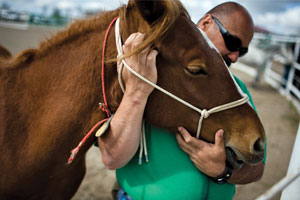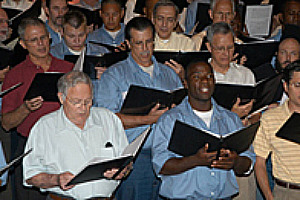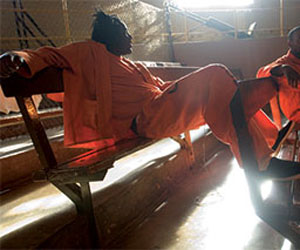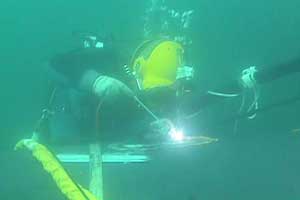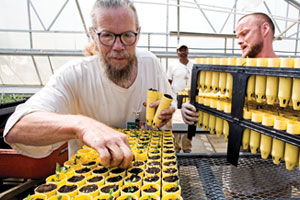
Photos: Benjamin Drummond
By the time Anthony McKinney gets out of prison, he will have missed his 20s entirely. He’s 28 now, a compact man with a short mohawk and a tattoo of a chain on his neck. “When I get out, I’ll be only 30 years old, and I’ll have 13 years of prison. If that was all time wasted, I would have come out a very experienced criminal, with a stronger body and a sharper mind,” he says. “That’s not what you really want to unleash on the community.”
It’s a cloudless day in western Washington, sunny and hot, and McKinney and three of his fellow inmates are tending to the apiary at the Cedar Creek Corrections Center, in Littlerock, outside Olympia. Until he was transferred here from a prison in Arizona, McKinney says, he was on the road to exactly that scenario. “I was very angry up until about six months ago,” he says. “I’ve been active in negativity for the past ten and a half years in the system.” The bees changed all that.
McKinney is one of about 60 inmates involved in the Sustainable Prisons Project, a collaboration between the state Department of Corrections and The Evergreen State College. The project began here at Cedar Creek, a minimum-security work camp, and has expanded to three other prisons. Inmates compost the facility’s food waste. They sort recycling by hand. They grow organic produce. They collect rainwater for the gardens. They raise bees. And they partner with scientists to do ecological research projects; right now, two of them are painstakingly raising endangered Oregon spotted frogs.
“If you can create jobs or activities for offenders that are educational in nature, what you’re doing is employing people and getting them out of their cells,” says the state’s deputy director of prisons, Dan Pacholke. “Any prison system will tell you that idleness is a bad thing. If we don’t have stuff for them to do, then we’re just going to hire more security staff.” Pacholke, 49, is a career DOC employee whose expertise is high-security response and emergency operations: escapes, disturbances, hostages, executions. His demeanor is easygoing, but he’s not the kind of man who spends taxpayers’ money on bleeding-heart projects. “It’s environmental economics,” he says. “We’re expensive places to operate. I could sell the [project] on cost containment alone: solid waste, energy, food costs.”
Cedar Creek’s 38-acre compound is located inside the Capitol State Forest, and as a result, the prison offered inmates green work opportunities long before anyone called them that—tree planting, brush clearing, firefighting. The work pays as poorly as most prison jobs, 25 to 85 cents an hour. But it has its rewards, says inmate Daniel Travatte, who works with McKinney in the apiary. “This is something else for me to do that’s positive activity, and I’m learning something. It’s something I’ll take with me when I leave,” he says.
 Biologist Sam Hapke teaches inmate Daniel Travatte how to tend bees. “This is positive activity and something I’ll take with me when I leave,” Travatte says.
Biologist Sam Hapke teaches inmate Daniel Travatte how to tend bees. “This is positive activity and something I’ll take with me when I leave,” Travatte says.
The air hums as McKinney, wearing a long-sleeved pullover and garden gloves, gingerly lifts a frame from one of the hives. Travatte has constructed each of these bars from slightly different material—one is plain wood, one is coated in wax, another has a piece of comb attached to it—and he takes careful notes on which materials the bees seem to respond to best. “They’re fascinating,” says Travatte. “It’s fun for me to keep track of different experiments, trying different things, and seeing what happens. It gives us something to talk about besides drugs, criminal activities. I’ve been to quite a few prisons, and I can tell you, when I get bored, I get in trouble.”
Back in 2004, Nalini Nadkarni was looking for people with a lot of time on their hands. A forest ecologist and Evergreen professor, Nadkarni was concerned about poachers, who were harvesting moss from old-growth forests to sell to florists. Nadkarni wanted to see if she could eliminate the demand for poached moss by growing it in a greenhouse. No one had ever tried this before, so she needed people to watch moss grow and gather data on which species could thrive in captivity, and under what conditions. Moss takes a very long time to grow.
Nadkarni, one of the nation’s preeminent experts in rainforest canopies, started asking herself, Who has a lot of downtime? “When you start thinking about it,” she says, “what population in the United States is completely devoid of nature, and doesn’t get to use their minds?”
She found her answer at Cedar Creek. By 2005, there were 8 to 10 inmates babysitting Nadkarni’s moss samples and taking meticulous notes. “The guys would come up to me and say, ‘Nalini, I’m really helping the old-growth forests, aren’t I?'” says Nadkarni. “That turned out to be incredibly important to them.”
Nadkarni is a spry 55. A mass of frizzy black hair dominates her delicate frame, and she is partial to sandals with mismatched socks. The daughter of a Hindu father from India and a Jewish mother from Brooklyn (who in 1952 married in New York because racist officials in Washington, DC, where they lived, had turned them away), Nadkarni has an explosive laugh, an infectious enthusiasm, and a notebook filled with drawings, notes, and to-do lists that she frequently pulls out of her bag. A tireless science evangelist—in 2001, the Guggenheim Foundation awarded her a fellowship to talk about her beloved forests to “nonscientists”—she gives sermons in local churches, synagogues, and Buddhist temples. Bringing moss to prisoners seemed like a natural extension of her mission.
It was at a dinner for Cedar Creek volunteers that Nadkarni met Pacholke, then the superintendent of Cedar Creek. She watched as inmates involved with the prison’s various volunteer-run programs—church groups, veterans’ groups, Toastmasters—”would stand up with the volunteer person and say, ‘I’m really glad Prisoners for Christ is here because they gave meaning to my life on the inside, and I’m not screwing up so much anymore, and thank you so much, Reverend, for coming,'” Nadkarni recalls. She had come with samples of moss and her own enthusiastic participant—a since-released inmate named Wayne Hudspeth. “And Wayne got up, and he just was so fervent about what he was doing—’This has changed my life, and I’m so grateful to Dr. Nadkarni for coming.’ And the tone in his voice was exactly like the tone in the Prisoners for Christ’s voice!” Nadkarni recalls with her giant laugh. “And I realized at that moment that I had something here that could go beyond the scientific stuff. I had a convert.”
Pacholke realized it too, and that night he and Nadkarni planted the seeds for a scientific lecture series at the prison; scientists would come in and talk to inmates and staff about topics like organic farming, composting, and water conservation. The lecture series, in turn, set off a chain of environmental projects at Cedar Creek. “They’d bring in a lecturer, we’d talk about it, and the business manager and I would say, ‘Hey, let’s do that,'” says Pacholke. Because Pacholke was the superintendent, he didn’t have to ask anyone’s permission, nor did he need extra money—the prison just used what it had to build what it needed. “We could turn around a project so quick!” he says. “In a month they’d come back and we’d be done, and say, ‘Hey, look at this!’ You can spend a million dollars on an in-vessel composter, or you can put in a concrete slab and hand a guy a thermometer and a water temperature gauge, and say, ‘Go out there and figure out how to make this work.'”
In 2008, the program went from Nadkarni and Pacholke’s scrappy and unlikely partnership to a more formal arrangement. The Department of Corrections has provided Evergreen with a $300,000 grant to administer and run the newly christened Sustainable Prisons Project. It’s led to savings that Pacholke is happy to rattle off: By conserving water, Cedar Creek avoided a previously planned $1.4 million expansion of its wastewater treatment facility; by recycling and composting, another facility sent two-thirds less waste to landfills this year—garbage can cost upwards of $100 per ton to haul.
The program that began at Cedar Creek has already expanded to three facilities, including Stafford Creek, a medium-security lockup in Aberdeen, a coastal town about 50 miles west of Olympia. A blanket of gray hangs low over Aberdeen—the staff calls it “sea fog” because it comes from the nearby Pacific—and even on a July day, the air has a soupy chill. Where Cedar Creek is a “work camp” with minimal fencing and bars, Stafford Creek is definitely a prison: metal detectors, rows and rows of razor wire, buildings like monoliths of concrete. Still, every few hundred feet there’s a patch of green or a splash of chaotic color—inmate-tended flower beds and lawns. The men are allowed to check out push mowers whenever they want, and today a solitary inmate is lost in thought as he runs a squeaky mower over grass that is already aggressively, emphatically short. Almost 2,000 men live here, but only a few dozen with the best behavior records are allowed outside the security “hub,” where most of the Sustainable Prisons Project activities take place.
There are five greenhouses and more than two acres of organic gardens. The inmates graze as they work, savoring the mellow sweetness of golden raspberries, running a thumbnail down a pea pod to pop out the green orbs. “When you can go to dinner and see your radishes chopped up in the salad, or onions in the potatoes,” says Travis Brown, carting a wheelbarrow full of weeds to the compost pile, “you know you did a little something productive.” These are luxuries that normally would not be part of prison food, and Brown tells his friends as much. “I make sure to let ’em know, ‘You know, that’s from our garden.'”
Because of the success of the moss project, a key component of the Sustainable Prisons expansion is that each facility should have a scientific research project. At Cedar Creek, the men who raise endangered frogs have a success rate much higher than professional counterparts in zoos throughout the state. Here at Stafford Creek, in collaboration with the Nature Conservancy and the US Army, inmates are growing rare prairie plants that are crucial habitat for endangered butterflies. Inmates Toby Erhart and Daniel Smith (who has since been released) oversee hundreds of thousands of little yellow tubes, each of which contains a single plant, which they’ve seeded, watered, and weeded by hand. These men are growing seedlings—early blue violet, showy fleabane, cut-leaf microseris—that biologists will use to replant prairie on a large scale on protected land at the Fort Lewis Army base just outside Tacoma. US Army biologist Rod Gilbert says that growing these plants at Stafford Creek will cost him about a penny a plug—about 100 times less than it would have cost in a commercial greenhouse. Without these men, growing the amount of plants he needs would have been “just out of the question.”
Erhart, 4 years into a 16- to 20-year sentence for rape and incest, is tall and thick around the middle, with hazel eyes and a thoughtful demeanor. Standing in the stuffy greenhouse, surveying the rows of tiny plants, he is clearly deeply proud of his work, but with Nadkarni visiting, he affects a casual scientific curiosity.
“What do you think of the project so far?” he asks her.
“You’ve got 98 percent germination! That’s amazing!” The men keep a logbook, in which they note dates and types of seed planted, time to germination, and other data. Nadkarni and the inmates trade hypotheses on why some of the plants grow faster than others. She says it’s clear they’re doing a wonderful job. “The plants are telling me that. It’s like the frogs at Cedar Creek,” she says. “They did better than any of the other facilities that have these professional wildlife people working on them.”
“Why do you think that is?” Erhart asks. He reaches down and absently plucks a weed from one of the tubes.
“This is like your link to nature,” says Nadkarni.
The men nod. “Plants actually feed off of you,” says Smith.
“Absolutely. And we feed off them. It’s a circle,” says Nadkarni. “And I think the circle you have is really tight, going on in this greenhouse.”
“It’s the constant care that we give them every day,” says Smith. “We get excited when we see them germinating. And the plant feels that, our excitement, so it thrives more.”
He thinks for a moment. “As far as the difference between here and maybe somewhere where a professional horticulturist is doing this as part of his job? You know, they do that for a living. We do it for 42 cents an hour. That’s not a living. We don’t do this for the money, and I think that’s what the difference is. We were hired from a pool of, what, 1,800 people that could be doing this? And we’re the ones doing it. We do it because we like to do it. If we didn’t, I don’t think the success rate would be so high.”
This is the crux of the issue that will confront the Sustainable Prisons Project going forward. All of the green jobs at Stafford Creek combined employ about 40 people—and the men who pull cardboard boxes out of the waste stream, who rebuild broken bicycles, who train troubled dogs for adoption, are some of the most motivated, best behaved inmates at the prison. They have to be, or they wouldn’t qualify for these jobs. What about everyone else? And if their interactions with science and nature are as transformative as they seem to be, wouldn’t the men who aren’t already changed be the ones who need it most? In other words, which comes first—does the work motivate the men to change their lives, or is it only the men whose lives are already changed that sign up?
Pacholke says that even those inmates who are not involved in the program are affected by it. He recalls the day they served salsa in the Cedar Creek dining room, with all the ingredients grown and harvested by inmates. They put signs up so the men would know where the food had come from. “There’s an educational component to that, because people start getting curious: ‘What do you do out in the garden?’ It changed the dynamic of the prison.” Like Travis Brown talking to his friends about radishes at dinner, “the informal network of their communication gets centered around more green kinds of activities.” What’s more, Pacholke continues, it’s sometimes hard to tell where the “green” jobs end and the regular jobs begin. The guys in the kitchen preparing the organic food, or scraping waste into the compost bins? They’re learning environmentalism, too, albeit on a much smaller scale.
And if the green activities are enough of a presence in the prison, maybe some guy will ride into the compound on a bus, in shackles, and see the stacked white boxes of beehives, and maybe this will put the germ of change in his mind. That is what happened to Anthony McKinney.
In the apiary, the grounds unfold around us in shades of green and brown. Cucumbers grow in a little garden nearby, and a patch of earth is upturned where the men harvested garlic yesterday. McKinney points to the lid of one of the hives, a white rectangle some three feet long and two feet wide. “If this whole board was who we are, about this much of it”—he traces a very small square with his finger—”is the part of us that got us in here.” It’s easy to imagine that small square. It’s filled with violence, drugs. Ego. Kidnapping, burglary, and robbery, which are what McKinney is here for. “It’s humbling to come out here, slow down, and see: There are other living things, and you’re not the center of the universe.” The bees, he says, “they’re aware of our presence here, but they really don’t care. I’m not important to them whatsoever.”
“I thought this was the world,” McKinney says of his little square, laughing softly. “That’s all I cared about. But there’s so much more to us, and there’s so much more growth that we can experience, if, not so much given the opportunity, but even just pointed in the right direction. If a door was opened, and said, ‘Look. Look what’s inside.'”
